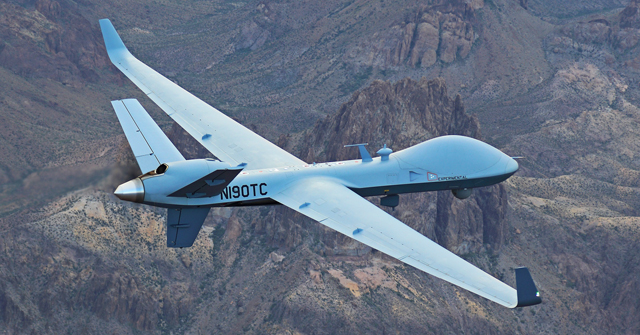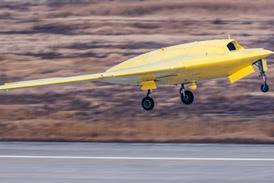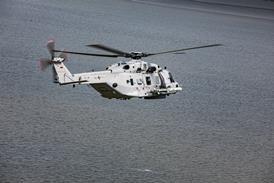As the USA struggles to bring its two counter-terrorism wars to a close in Afghanistan and Syria, General Atomics Aeronautical Systems, which first rose to prominence after 9/11, supplying the CIA and Pentagon with its MQ-1 Predator unmanned air vehicle (UAV), is also trying to move on.
In recent years, the manufacturer has invested heavily in new UAVs, including a Federal Aviation Administration-certificated version of its latest aircraft, the MQ-9B SkyGuardian (below), and a proposed unmanned, carrier-based aerial refuelling tanker for the US Navy.

General Atomics Aeronautical Systems
The former aircraft, though still in development, is receiving orders from countries including Belgium and the UK. But its latter offer, the MQ-25, will never leave the factory, despite a $200 million investment in its development over the past eight years by the Poway, California-based company. Last August, the USN announced that General Atomics and fellow competitor Lockheed Martin had lost out to Boeing's cut-rate price of $805 million to develop and produce four MQ-25A Stingray aircraft for the service.
The loss still stings, says General Atomics president Dave Alexander.
"Of course, we are super-disappointed we didn't win. We thought we had the best airplane by far. We scored a perfect score with NAVAIR – the toughest air agency in the world," he says. "We got as high as you can get in every category. On top of that, we got 23 risk-reducers based on how much margin we had in our design and how much margin we had in our schedules."
The company bid for the contract as tightly as it could, says Alexander.
"When the RFP came out and it was fixed-price incentive fee, two bidders, and it doesn’t have to be a reasonable bid, we knew what that meant," he says. "We kept going. And we just figured, 'Well, we have to try to win'."
Ultimately, Boeing's lowest-priced bid won. It was the first of a string of three contracts the firm won over the course of August and September 2018. This also included a firm, fixed-price deal to replace the US Air Force's Bell UH-1N utility helicopter fleet with the MH-139, jointly offered with Leonardo Helicopters, and it also secured the USAF's T-X trainer contract.
RIVALS RILED
Boeing’s consecutive wins using rock bottom prices have drawn criticism from competitors, including Lockheed chief executive Marillyn Hewson, who said last year that matching the Chicago-based manufacturer's bids on price would cost her company billions of dollars. For its part, General Atomics incorporated Boeing as a junior partner in its MQ-25 bid, while at the same time competing against it.
"We are still great friends with Boeing," says Alexander. "We are collaborating with them on other things. So we will work with them in the future."
If anything, the UAV specialist's position on the MQ-25 loss is matter of fact.
"If the government keeps going out with these types of [fixed-priced] programmes they are going to boil themselves down [until] they get what they get from the big three [defence manufacturers]," says Alexander. "You’re not going to get any innovation from a medium-sized company, nor will they get an awesome airplane like what we proposed to them."
As a medium-sized company – with medium-sized financial resources – General Atomics is unable to sell UAVs at an upfront loss with the hope of making a profit in the long run. In contrast, Boeing's strategy for a variety of military programmes has been to bid low prices upfront, and rely on earnings from its commercial airliner business to sustain its defence units until a profit can be made in the future via international sales or additional services.
"If an RFP comes out for a major programme of record we are all in; we are going to go after it again," says Alexander. "But we are at a disadvantage because we basically have to bid a programme at what it will take."
That is not to say General Atomics is bitter from the experience.
"We’ve got no sour grapes here," says Alexander. "Zero."
In fact, the company is already eyeing future competitions, including the US Marine Corps' MUX programme and the US Army's next-generation UAV programme. The MUX programme asks for a vertical take-off and landing UAV, and while General Atomics has never built such an aircraft, Alexander says: "We are part of the bid and we are in there."
FROZEN OUT
Meanwhile, although US government procurement policies may be vexing for General Atomics, the Trump administration's new, relaxed drone export policy is not. The company is trying to regain ground lost to Chinese manufacturers, competitors which in recent years have eroded its market share by selling cheaper, knock-offs of its products, especially to countries in the Middle East.
The company says that during the Obama administration's tenure it was unable to compete with Chinese rivals in a number of countries because of restrictive UAV policies.
"With the new administration and the new policy, frustration levels are coming way down. Prior to that, it was just like, 'Oh my God, what are we doing?'" Alexander says. "We are just handing these customers to the Chinese."
Alexander dismisses any presumption that Chinese manufacturers will not improve their products to the point where they are directly competitive.
"[Critics say]: 'Oh, their stuff isn't good.' Well, yeah. That's today. Tomorrow, it's going to be good," he says. "Trust me – they are smart. They'll learn. They'll get better and better as they go. You know, we weren't very good in the beginning either."
What is more, says Alexander, once a competitor gets a foothold in a country, it could take 20 to 30 years to push them out.
"You get ingrained with your logistics, your depot line, your MRO and you're in," he says. "They’re in!"
Nonetheless, General Atomics says the new policy was introduced just in time and has helped to head off the competition at the pass, making a difference in closing sales.
"Things are all going in the right direction, from being blocked to now being helped," says Alexander.
Source: Flight International























